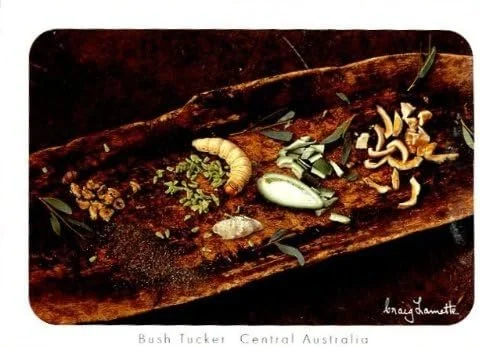Oh, the things people will eat!
Bush Tucker (witchety grubs)
In the Philippines, roast dog is said to be a common dish in many homes. Camel tendons are served in China, as well as jelled duck or pig's blood. And in Scotland, of course, there's the traditional haggis -- a sheep's stomach, stuffed with steamed oatmeal and spices.
People eat criadillas (bull testicles) in Spain, cibreo (cock's combs) in Italy, tacos sesos (tacos made with cow brains) in Mexico, water bugs in Thailand, witchety grubs in Australia, roasted ants in Columbia, and spiders in Cambodia.
You might want to wash these down with a beer-like Russian kvass made from fermented stale bread or the Grecian white wine retsina spiced with pine resin, or the fluorescent orange Irn Bru soft drink from Scotland which tastes something like bubble gum.
Some of these culinary delights can make America's okra, ramps, spruce beer and fried dill pickles seem pretty tame, but food historians can point to the baby-booming days of the 1950s and 60s as a landmark period of gustatory ingenuity and tastelessness in this country as common housewives proudly served up Chocolate Sauerkraut Cakes and Banana Meat Loaves and platters of Spinach Mold.
It wasn't privation that drove post-war Americans to prepare Fiesta Peach-Spam Loaves or Tomato Soup Cakes. Prosperity suddenly filled the grocer's shelves with a dizzying variety of canned meats, imported produce, exotic nuts and spices and the newly invented Spam, Cheese Whiz and Jell-O. The modern kitchen became a center for creative nutrition, where the seven food groups were being combined in ways never before attempted.
"This was an age where people were experimenting with color and bringing some fun into their meals," writes Kathy Casey in the introduction to Retro Food Fiascos, a deliciously funny collection of recipes from popular magazines, cookbooks and food companies.
"Imagine eating the following ultra creative mold in a contemporary restaurant: lime Jell-O, sour cream, pineapple, walnuts, pimento-stuffed olives, and cottage cheese. Makes you wonder if this wasn't a time of heavy drinking in the kitchen."
Some samples from Casey's book provide a taste of this curious era:
"Hawaiian Sandwich." Spread a little boiled or diced veal sandwich-style between two slices of pineapple. Top with a sliver of pimiento circling a few toasted almonds.
"Red Hot Salad." Dissolve a couple packages of cherry gelatin in boiling water with four ounces of Red Hots candy (also known as Cinnamon Imperials). When cooled to room temperature, add pineapple and applesauce and pour into an oiled 8-cup mold and chill. Serves 8.
"Veal-Oyster Loaf." Mix together oysters, veal, corn flakes, onion, milk, eggs and seasonings. Pack into a loaf pan and bake. Serve with Swiss cheese slices and garnish with parsley sprigs.
"Velveeta Cheese Fudge." Melt a pound of butter with a pound of Velveeta Cheese. Mix in cocoa, powdered sugar, nuts and vanilla. Spread, cool, cut into squares and serve at your dinner party.
Oh, there's much more! Casey's collection includes complete recipes and instructions for Fresca Cake with Maraschino Frosting, Sausage-Filled Prunes, French Onion Soup with Coke, Jellied Moose Nose, Crown Roast of Frankfurters, and Prune Milk Shakes.
Every culture, it seems, adopts strange food customs that confuse or disgust outsiders. Some are cultural markers that separate the strong local folks who like (or at least tolerate) a dish from those weak-spirited newcomers who gag. Other dishes, like the Pepsi-Cola Cake with Broiled Peanut Butter Frosting or the Yankee Doodle Pizza Pie made with Ann Page Pork and Beans, are just food marketing experiments gone awry.

